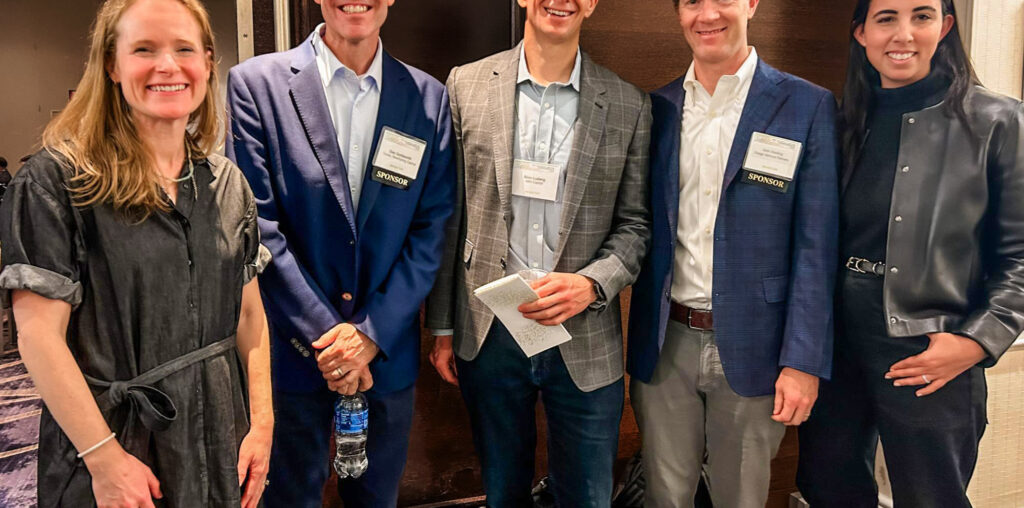From seed to Series A to growth, entrepreneurs at every stage ask the same question: What are investors really looking for when evaluating founders and their businesses?
At this year’s Mid-Atlantic Capital Conference hosted by PACT, the question was as present as ever. Nearly 300 investors from across the region, representing capital from Norfolk to New York and beyond, participated in startup showcase sessions featuring over 60 technology, life sciences and healthcare startups.
Raising investment capital is a process. It is art and science, personality and projections. This event had both.
Investor buzz culminated in the Lion’s Den, the conference’s own version of Shark Tank that included local notables such as Eagles tight end-turned-real estate entrepreneur Brent Celek, cloud software entrepreneur-turned-Philadelphia Union investor Matt Wallach, and Nicole Hantas-Emanuel, the cofounder of infused tequila brand 21 Seeds and former CFO of AngelList.
After listening to pitches and peppering founders with questions, over $1M was committed live to three startups — commercial air purification company Carbon Reform, AI governance software FairNow.AI and Integrated Reality Labs, which integrates IRL games into mobile apps.
Entrepreneurs in attendance looking for their own path to investment gained advice with a much higher valuation from a different panel of financial professionals.
“Knowing that you are going after big bets and big markets, what are the proof points you are looking for, knowing that this is a longer journey?” asked Dan Goldsmith, Philadelphia-based CEO of Tendo and partner at NewSpring Capital, to the headline panel, “Positioning Your Company to Raise Capital from Venture and Growth Investors.”
To a packed house, a group of experts — and, most importantly, active investors who represent over $1.3 billion in deployable capital — shared insider logic of investment decisions and tactical strategies for the end to end lifecycle of the deal. From securing the investment to growing the business to navigating the right exit, entrepreneurs got more than advice.
The key takeaway for founders: While the investment climate may be volatile, the questions investors are trying to answer remain steady:
- Why are you the team that will be successful?
- What are the key metrics that prove that your business is progressing?
- Where is the company headed?
Rather than opine on the market and future of venture capital fundraising, panelists shared tactical recommendations and metrics to help entrepreneurs understand the mechanics of how investors go about answering these three questions long before and well after the check is written.

Getting the deal done is about building the relationship
Whether in a period of market expansion or contraction, professional investors are mandated to stay steady and continue to responsibly deploy capital. For startups, the trickle-down effect from macro-economic conditions is not the size of the check or the amount of investments made.
What changes most readily? The length of time it takes to get an investment done.
“It is unusual for us to make an investment in a company that we have been interacting with for less than a year,” said Bion Ludwig, general partner of ABS Capital, a growth equity firm headquartered in Washington DC that invests from its ninth core fund in tech and tech-enabled services businesses with annual recurring revenue from $8M-$9M up to the $40M-$50M range.
Panelists agreed that the period of building the relationship with the entrepreneur is just like any other enterprise sale cycle; it must be run as a sales process, with drip campaigns, update calls, informal interactions at conferences, all the way through to formal meetings.
“You have to be targeted, aligned, and understand the investor as a customer.”
Sean Dowling, Osage Venture Partners
“Talk to 50 people. Navigate a funnel. Identify ideal investors, qualify them. Don’t talk to me if you have a consumer business. You have to be targeted, aligned, and understand the investor as a customer,” said Sean Dowling, managing partner of Bala Cynwyd, PA-based Osage Venture Partners, which invests in B2B early-stage startups with $1M in revenue run rate in up to a $10M round, and is currently investing out of their fifth fund.
Allison Pickens, operator turned first-time solo GP at New Normal Fund, investing $500K to $1M checks at the early-stage in companies nationwide from a San Francisco HQ, helped make this actionable by suggesting tactics.
Her advice to founders was to commit to monthly emails with targeted asks and transparent and honest acknowledgement of where help is needed. The more targeted the ask, the more impactful the action can be. Additionally, letting investors in on how you think, how you approach challenges, and how you lead, is a critical factor in providing evidence that you will have a great relationship once the check is written. Just as the investor aims to earn the trust of the entrepreneur, the entrepreneur must earn the trust of the investor.
Progress is proven through prescriptive and predictive metrics
The team, the business, the opportunity. The base factors that investors evaluate the potential value of a startup on and their ability to win or fail. Touching on different aspects of each, the panel put their emphasis on metrics that are indicators of growth and efficiency.
General but critical qualitative and quantitative metrics discussed included:
- How well does the management team work together?
- How well does the management team work with others?
- Does the team have domain expertise in the pain?
- Does the team have business building experience?
- Is the problem being solved as a low pain point or a top pain point?
- Is there product-market-fit and how does the company define that?
- Is there an opportunity for the investor to create value and help?
- How enthusiastic are customers?
- How has the contract size changed over time?
- How have the conversion rates changed over time?
- How have the margins changed over time?
- How has the company represented the TAM over time?
- How does the company incentivize the team?
- Does the team have experience in startups?
- How does the company view the responsibility of sales?
Measuring the specifics of customer value and efficiency were the most discussed by the panelists as significant indicators that can forecast success.
Product usage, contract renewal rates, relationship expansion or even a tracked number of things or customer actions that drive ROI serve as indicators of how customers are getting value, and become the critical signals for an investor’s evaluation.
Pickens, of New Normal Fund, called this out as a “North Star” metric that serves as a “proxy” for value delivered to customers. “Track that number religiously. If that number is growing, chances are your revenue will grow, and fundraising is going to be a lot easier.”
Ludwig, of ABS Capital, noted his firm uses a similar efficiency metric called Core SaaS Profitability, calculated as “gross margin less all non-sales-and-marketing cost.” He explained this is used as a “calibration tool” to “determine how much capital can the company absorb today in order to continue to scale at the same amount of efficiency that we’ve seen historically.” This enables the investor team to recommend raising either more or less capital to achieve milestones of growth while achieving ownership goals and define the efficiency of the use of capital of the business.
When it comes to AI, Adina Davis, investor at BoxGroup, an NYC-based, software-focused, pre-seed to seed stage fund deploying from a $425M sixth fund, brought major perspective to the overly-hyped space.
“Today, AI feels like a vertical but is very quickly going to become a horizontal,” Davis said. “Fifteen years ago, people talked about mobile as a category. Now everything is mobile, no one even lists that anymore.”
Pickens, who focuses her investments into AI companies, added that the value of AI comes down to one metric to remove the noise. “The contract size is the indicator of whether AI is a fundamental part of the product,” she said.
Acknowledging that recent major advances in LLMs have driven rise to new categories, altered the growth trajectory of companies, and created new use cases for software that were previously untapped, Pickens said AI is most valued when it reduces complexity and increases efficiency.
Popular and relatively easy to implement AI features — like a chatbot or document digestion that may unlock 10% to 20% productivity growth — are nice-to-have, but AI capabilities that unlock a five- to six-figure annual enterprise contract is when it gets investable, from her perspective. For venture investors, this “unlocks” new TAM, meaning there is significant increase in the total size of the addressable market for the product and ultimately the total potential outcome of the investment.
Exit planning is about ‘why,’ not ‘when’ or ‘who’
There is an overemphasis on the investor value of a big-idea with earth-shattering, industry-changing potential. The truth is, not every company has to change the world. The majority of investors are looking for a “high quality business” that can be grown into “good margin business.”
Asked their biggest turnoff, panelists resoundingly agreed that “overly aspirational” founders who lack a “grounded view of reality” and “overestimate future potential” results in an immediate “Pass.” Investors want to see people hyper focused on the journey, rather than overfocused on the outcome.
When a VC is getting serious about investing, they build their own financial model, taking data provided by the founder, turning it into their own version of what is achievable, reasonable and ultimately returnable. If that lines up positively with all the other additional qualitative and quantitative data points they’ve gathered over the last year or longer of your relationship, there is a deal to be made.
“If it feels too early to sell your company, that is a good sign you should be selling your business.”
Bion Ludwig, ABS Capital
Credible, investable pitches emphasize the things that a team set out to do, how that went and how those results define the plan of where the entrepreneurs want to take that business with the capital raised. They don’t start at who is going to buy the company, because the truth is you can’t yet know the end. The end is determined by momentum.
As Ludwig put it, “Exits, unlike raising capital, represent a single point in time. When you’re fundraising and collecting term sheets, [if] one is a percent more [and] one is a percent less, that is not really going to drive the outcome.” At investment, there is significant opportunity through the efforts of both the entrepreneurs and the investors to drive the valuation over the ensuing months and years of the business. But when you are trying to exit the business, that is the moment of maximal outcome definition. That is when the final valuation is made for founders, and the upside is determined for investors.
The logic is hard to argue. Put in another year and the math says the company is going to be 30% bigger, 30% more valuable. Balancing the reality of the market signals up against performance dynamics of profitability, growth, strength in the team, it still may be time to sell. All of the years of work, summed up into a transaction number.
At the close of the session, every entrepreneur in the room leaned in, imagining their own version of the future.
”It’s painful. I know a lot of people who made a lot of money selling their businesses too early,” said Ludwig. “It always feels too early. If things are going well and it feels too early to sell your company, that alone is a good sign that you should be selling your business.”

